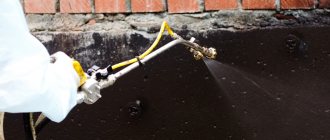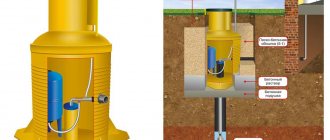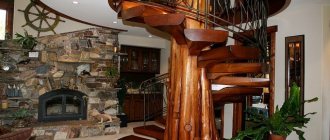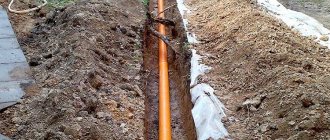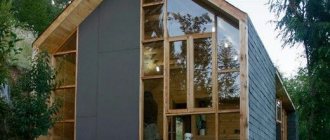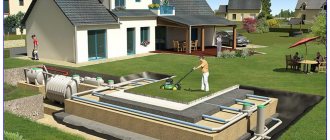In this article we will look at a diagram for installing water supply pipes in any private house with our own hands. It is quite difficult for a person without special training to understand the intricacies of arrangement, but we recommend that every home owner understand the basics. This will be useful for monitoring the work of installers, as well as for choosing the optimal supply option. Laying a pipeline is no less significant a task than organizing a network of pumping equipment. We will provide all the necessary information to make it easier to understand the specifics of the device and the rules, in addition, everything is based on regulatory requirements.
Types of water supply wiring in a private residential building according to the drawing
There are 2 main types of water supply, which is carried out in households:
- autonomous - everything comes from a personal well or a drilled well;
- centrally - supply from a special line that takes resources from a tower or a station designated for this.
Both methods have their positive and negative sides; you should decide on the subspecies before starting installation, because each of them has its own characteristics. The final cost of the entire process also depends on the choice. Although there are situations when only one of the methods is possible (for example, in the absence of a centralized water supply system) and then there is no choice.
Scheme of input and connection of water supply (water) of a residential private house from the central water supply
When choosing a system, you should think about several criteria:
- is there a water main in the area? It’s funny, but people sometimes forget to take this into account;
- what quality of moisture is supplied - it happens that it is only technical, it is not recommended to drink;
- how reliably and uninterruptedly does the supply function? In some regions there is pressure only by the hour or on days of the week;
- does it depend on external factors - some lines stop working in winter;
- how expensive it is - sometimes it is much cheaper to drill your own well than to crash into a working highway.
How to distribute water around the house if there is an autonomous water supply
When an owner wants to equip his personal well, he should prepare for large labor and financial costs even at the construction stage. First you will have to dig a well or drill it, draw up the correct technical plan, select and buy equipment. Only then will you need to mount and connect.
If you do not focus on the price of this choice, then it has many advantages:
- you don’t have to depend on any external factors;
- can be carried out everywhere, it is especially convenient where there is no common highway;
- no need to pay monthly;
- The quality of moisture is usually much higher, in addition, you can install any filters if necessary.
If it turns out that the source is not clean enough and drinking from it is not recommended, then special treatment facilities can be installed. This will greatly clean and improve the condition of the liquid, making it suitable for cooking and drinking. Choose such a device on our website, and if you have any questions, the managers will be happy to answer them.
Well water supply system
The water supply to a private house is carried out from a buried well, which is drilled “into sand” (up to 30...40 meters) or “into lime” - an artesian well (from 60 meters). A caisson consisting of two compartments is installed on the well (2). Compartment A (1) has a sealed well head (3), which prevents the outflow of water from the well, its contamination and the entry of foreign objects into it. A submersible pump (4) is lowered into the well and mounted on a pipe (first lift level).
Through the pressure pipe of the submersible pump, compartment A is filled, which serves as a control tank. The pump is controlled by the upper and middle floats of the float group (5). In compartment B, a pressure boosting pumping station is installed (second lift level), which can be made of one or two pumps.
The pressure booster unit of compartment B takes water from reservoir A and supplies it to the entry point into the house. The pressure boosting pumping station is controlled using signals from an analog pressure transducer or sensor-relay. The pressure boosting station is switched off according to the level of tank A using the lower float of the float group (5). The pump control panel (13) can be located outside the pavilion and allows for remote control of all pumps and monitoring of their condition. The well and pumps are located outside the living space and are buried in such a way as to prevent freezing of water in the pumps and well in winter. The location of the well inside the well ensures the possibility of its maintenance.
Fig.8. Individual water supply system with submersible pump
Advantages of water intake:
- high productivity, which is determined by the power and number of pressure booster pumps. When increasing the productivity of the pressure booster installation, it is necessary to increase the volume of the control tank A (from 3...4 cubic meters);
- The efficiency of the pressure booster installation is higher than when working with an Abyssinian well;
- the possibility of raising water from a greater depth than that of the Abyssinian well;
- water supply sustainability;
- ease of maintenance;
- high water quality;
- significant service life with proper use.
Features of system operation:
- periodic treatment of tank A is necessary to prevent the formation of silt deposits;
- it is advisable to chlorinate the water in tank A;
- during winter conservation, it is necessary to completely de-energize the pumps, and then drain the water from tank A using a drainage pump to the groundwater level;
- after winter conservation, before starting the system, it is necessary to completely drain the water from tank A and treat it;
- During continuous operation, preservation of the control tank is not required.
The water column is drained into the well before winter conservation through an additional drain pipe (8), which is cut off by a valve or shutter (9). In technological compartment B, additional equipment for water purification (chlorination, bactericidal treatment) can be installed.
It is necessary to note the advantages of using a two-pump pressure booster installation compared to a single-pump installation:
- ensuring a given pressure over a wide range of flow changes;
- high efficiency;
- possibility of pump redundancy;
- greater resource.
The water supply system under consideration can be used as a centralized or group water supply system. The system can operate all year round if periodic maintenance is performed. For such a system, you can use an artesian well, and it is necessary to make calculations for the choice of a submersible pump, the volume of the control tank, as well as the power and number of pressure booster pumps. Installation of additional water purification equipment in centralized or group water supply systems in terms of price will not be critical for individual consumers. In addition, it is possible to organize qualified maintenance of the system and monitor its condition. In front of each individual house with a centralized or group water supply, it is possible to install a pressure booster pump, also installed in a recessed caisson. This will ensure a more stable water supply to each home when using a centralized or group water supply system. When organizing water supply to a sufficiently large number of individual houses or an entire village, the intensity of water supply increases, which leads to the need to increase the power of the pressure booster installation, and accordingly, increase the volume of the control tank. When performing calculations for such systems, it is necessary:
- Set the parameters of the pressure booster installation depending on the required water supply parameters.
- Determine the capacity of the supply tank (or tanks).
- Determine the power of the first lift level pump based on the well flow rate.
Depending on the flow rate of the well and the required parameters of the water supply, several wells can be drilled at once with the installation of caissons on each of them. Calculations show that for water supply to the village it is necessary to use separate containers of sufficiently large volume. The tanks provide water supplies for domestic water supply and fire fighting. The village water supply system, unlike group water supply systems, will require more complex calculations and detailed studies reflected in design solutions. An enlarged diagram of the village water supply installation is shown in Fig. 9.
Rice. 9. Scheme of the village water supply installation
The designs of caisson water supply systems we offer have a number of advantages over other systems:
- For individual and group water supply systems, in-depth development of design solutions is not required, because the system consists of complete functional elements. The appearance of the system is determined, first of all, by the choice of the source of water (mine well, Abyssinian well, sand well or artesian well), as well as the calculation of the first (if any) and second level pumps, depending on the specified pressure / flow parameters . It should be noted that an artesian well is somewhat redundant for one individual house.
- Minimum amount of construction work. The equipment is supplied in a modular design. It is only necessary to prepare a pit, drill a well, prepare a technological well from concrete rings for the Abyssinian well, lower the caisson into the pit, “plant” it on the well or connect it to an existing well, install and connect the pipelines.
- Compact placement of water supply system equipment does not require additional space inside the house.
- Pumping equipment and pipelines do not require preservation in winter and are under constant flooding, which significantly increases the service life of the system.
- It is possible to connect a caisson pressure booster unit to an existing well.
Photo of the installation diagram for a water supply system, which is usually used in a private country house
There are 2 ways in which the connection can be made - in series, one after the other, and in parallel, when everyone is turned on at the same time. What to do at home depends on how many people live, whether they are there permanently or periodically, and how intensively the water supply is used.
In some cases, a mixed type is used, when all mixers are connected through a manifold-combiner, and all other elements must be connected in series.
If the connection is serial
It looks like alternately supplying pipes that lead from the riser or water heating device to the plumbing and taps. First, general ones are diverted, and then branches go from them through tees to the places where moisture will be consumed.
This is a more economical method; it is often used in apartments and small houses. The essence of saving is in a small amount of materials, and the installation itself is simplified. The system will be compact, it will be easier to hide it under the decoration.
A serious drawback is that if several people use hot liquid at the same time, then at the most distant point the pressure will be significantly lower than at others.
Another disadvantage is that if you need to repair or connect any of the plumbing fixtures, you will need to disconnect the entire housing from the supply.
This is why we recommend using a different scheme in private homes with high consumption to avoid problems with operation.
If the connection occurs in parallel
This option is based on the fact that the pipes themselves go from the main collector to the points where water intake will occur. Separate nodes are placed for each line.
It will be necessary to lay a lot more pipe lines, which means that it will be difficult to camouflage them. And any part with a tap or appliance will have a stable, unchanging pressure, even if several plumbing fixtures and taps are used at the same time. Changes in pressure will be minimal, the pressure will be even.
A collector is a device that has one input and two or more outputs. Their number will depend on how many nodes and equipment the source uses.
MBFT-75 Membrane for 75GPD
SF-mix Clack up to 0.8 m3/h
SF-mix Runxin up to 0.8 m3/h
For cold water supply this is done before entering the premises, and for hot water supply - immediately after the water heating product. A cleaning filter and a reducer are installed in front of the collector, which will control the pressure.
Classification of water supply systems
Water supply systems can be classified according to a number of basic characteristics.
- By purpose:
- water supply systems for populated areas (cities, towns);
- industrial water supply systems;
- agricultural water supply systems;
- fire water supply systems;
- combined water supply systems (household-industrial, utility-fire-fighting, etc.);
- According to the method of water supply:
- gravity (gravity);
- with mechanized water supply (using pumps);
- zone (to some areas by gravity, to others by pumps);
- By the nature of the natural sources used:
- receiving water from surface sources (river, lake, etc.);
- receiving water from underground sources (spring, artesian, etc.);
- mixed type;
- By way of using water:
- direct-flow water supply systems (with single use of water);
- recycling water supply systems;
- water reuse systems.
If the water supply is external, where is the housing supplied from?
There are several schemes for distributing water in every private house without do-it-yourselfers, let's look at them in more detail.
Central water supply
The most budget-friendly way to organize water indoors. To cut in, you need to get permission from the settlement administration, then install meters, install equipment, and lay a pipeline to your home. Another condition is the installation of a septic tank or other wastewater treatment facility.
Well
One of the most common mining methods in suburban areas and in the country. Typically used where the liquid is shallow. The main advantage is that even if there is no light or pump, you can still fill a bucket, even with a lot of effort.
Well
The purest liquid of all the options proposed above. There is more of it, you can simultaneously provide several areas at once. But creation requires significant investment, and a license for use will also be required.
Schemes and equipment for cold water supply
What will an autonomous water supply at home look like in each of the described cases?
Well
Conditions: the depth of the water surface does not exceed 8 meters.
Equipment:
| Image | Description |
| Water supply pumping station. This is the name of a set of a centrifugal surface pump installed on one frame, its power relay with a pressure sensor and a hydraulic accumulator. The pump turns on when the pressure in the membrane tank drops below a critical level (usually 1.5 kgf/cm2), and turns off after it reaches the upper specified value (3 - 6 kgf/cm2). When water consumption is insignificant, the pump is idle, and excess pressure is provided by compressed air in the hydraulic accumulator. The station is selected based on pressure (it must exceed the height of the upper water intake point above the pump by at least 15 meters) and performance (it must be at least equal to the peak water flow through all simultaneously used devices). |
| The suction pipe is a rigid pipe through which the pump draws water from the well. |
| A check valve that prevents the discharge of water from the membrane tank through the suction pipe when the pump is turned off. |
| Water supply inlet connecting the pumping station to the internal water supply. |
| A mechanical filter that purifies water from suspended matter. Modern plumbing (primarily ceramic faucets and cartridges of single-lever faucets) really do not like sand and other debris in the water supply: a grain of sand caught between the plates blocking the water can damage them. |
Please note: the maximum suction depth (those 8 meters) has nothing to do with the power and performance of the pump and is the same for all models on the market. The limitation is imposed... by atmospheric pressure: it is this that displaces water into the suction pipe when a vacuum is created in it. Under ideal conditions (with absolute vacuum in the pipe), the height of the water column cannot exceed 10 meters.
Calculation of the maximum height of the water column at atmospheric pressure
Scheme: the pumping station is installed in an insulated house above the well or in a warm room of the house (with a short distance to the well). The check valve is mounted at the end of the suction pipe, the coarse filter is mounted at the water supply inlet.
Pumping station in a house above a well
Please note: if there is a large amount of suspended matter in the water, the filter can be installed on the suction pipe, in front of the check valve. However, in this case, the pipe will have to be lifted periodically to clean the filter.
Well
How to implement an autonomous water supply in a house if the water source is a well (see Water supply from a well: how to do it yourself) or a well more than 8 meters deep?
Equipment:
| Image | Description |
| Borehole submersible pump. The pressure it creates must be at least 15 meters higher than the difference in height between the water intake point and the upper water intake point. For a significant length of the water supply inlet, the calculations use an additional coefficient of 1.2, which is necessary to compensate for the hydraulic resistance of the pipe. |
| Non-return valve that prevents loss of water raised by the pump. |
| Power relay with pressure sensor. It turns the pump on and off when the lower and upper threshold pressure values in the water supply system are reached. |
| Hydraulic accumulator. It acts as a buffer, eliminating pressure surges during pump operation. |
| Mechanical cleaning filter. It again protects the water supply from suspended matter and debris. |
Scheme: a pump with a check valve installed on the outlet pipe is immersed in the well. The water supply inlet is laid below the ground freezing level. The hydraulic accumulator and pressure switch are mounted at the inlet or at any other point in the water supply system.
Scheme of water supply from a deep well
Capacity
How to organize an autonomous water supply for a dacha or home from a storage tank?
Gravity water supply
Equipment:
| Image | Description |
| Storage tank. Plastic (polyethylene or polypropylene) containers for drinking water are usually used in this role. They are usually equipped with a filler hatch and one or two pipes for connecting to the water supply. |
| Float fill valve. It is needed if the container is filled from a summer water supply with periodic water supply. The valve allows you to automate the filling of the tank. |
| Shut-off valve (usually ball valve). It allows you to drain the water supply for plumbing repairs without dumping the storage tank. |
| Check valve. It is needed if the container is used as a backup source of water, and prevents its filling through the drain pipe. |
Scheme: the container is installed in the attic of the house, or under the ceiling of a residential floor. It is filled when water is supplied to the summer water supply or (if imported water is used) using a pump. Water is supplied to the water supply system by gravity through the drain pipe at the bottom of the tank.
Please note: a scheme with a buffer tank and gravity water supply can also be used if you have your own water source - a well or well. Its main advantage is complete energy independence (of course, after filling the tank): even during a long power outage, the home owner will not have to do without water.
Scheme of water supply from a well with a buffer tank
Gravity autonomous water supply in a dacha is more than appropriate, but in a private house such a scheme is somewhat inconvenient:
- The water pressure is limited by the height of the tank;
Reference: household appliances (washing machines, water heaters, dishwashers) operate at a pressure in the water supply of at least 0.3 kgf/cm2. It corresponds to the pressure created by a water column 3 meters high.
The Atmor Basic water heater operates in the pressure range 0.3 - 6 kgf/cm2
- The tank can only be installed in a warm room. In a cold attic, water will freeze during the first frost of the night;
- The water supply in the tank is limited by the strength of the floor beams.
It’s interesting: gravity supply of water into the water supply system has been used for many years to provide water supply to apartment buildings and even entire settlements. Buffer tanks in water towers were filled with water from any local source - a well or a water intake from an open reservoir. Now this water supply system has been practically replaced by pumping stations.
Apartment building on an autonomous water supply with a water tower
Water supply by pump
An autonomous water supply in a private house with water supplied from a storage tank by a pumping station does not have all the disadvantages described above. To implement this scheme, you need the pumping station itself, a float valve, a water tank (its volume is limited only by the size of the room allocated for water reserve in the basement or ground floor) and a pair of check valves.
Storage tank with pump in the basement
Scheme: the container is filled through a float valve or (if the water is imported) through the filler hatch. The input of the pumping station is connected to the drain pipe of the container. Check valves are placed on the outlet pipe of the pump (the valve does not allow the container to be filled through the drain), and between the taps of the container and the pump into the water supply.
Scheme of water supply from a storage tank with a pump
Captain Obviousness suggests: this scheme can also be used as a backup source of water in a house with its centralized supply.
How does it work:
- At normal pressure in the main water supply, the check valve at the outlet pipe of the pump is activated. The second valve is open. Water enters the internal water supply and fills the tank through a float valve;
- After filling the tank, the float valve shuts off the water, but it continues to flow into the water supply;
- When the pressure drops below the response threshold of the pressure switch of the pumping station, the pump turns on. The check valve at its outlet opens. The second valve closes and prevents water from draining into the water supply main. Until the inlet pressure stabilizes, the house is fed with water from the tank.
Types of wells
There are only 2 main subspecies. In the first case, you can drill an artesian, which has a depth of up to 150 meters, or a regular one, “into the sand.” The second one does not go deeper than 15-50 meters.
They also differ in the time they can be used. The former last up to 50 years, and the latter usually no more than 20 years.
Water supply systems using submersible pumps
1.1 Submersible pump without storage tank
A typical diagram of the most common water supply system using a submersible pump without a storage tank is shown in Fig. 1. Water supply using submersible pumps is carried out mainly from wells (in some cases - from wells and reservoirs). Wells are drilled “on sand” (up to 40 meters) or “on lime” (from 60 meters - artesian wells). In the second case, permits and registration documents are required. The choice of well is determined by the aquifers, as well as the specified water supply parameters (pressure / flow).
Fig.1. Autonomous water supply system using a submersible pump
In any case, the condition for year-round use of a well is its caisson, which ensures sufficient depth of the head and protection from freezing. The main disadvantage of such a system is that the submersible pump as such is not designed to create pressure. These pumps were originally designed to fill control tanks located after water intake structures, and not to create a given pressure at a variable flow rate.
Diagrams of the operating characteristics of submersible (well) pumps type SQ manufactured by Grundfos, recommended for water supply to private houses, are shown in Fig. 2.
From the diagrams given (for example, for the SQ5 pump) it is clear that when the flow rate increases from 5 to 6 cubic meters/hour (by 16.7 liters/min), the pressure decreases by 17 meters (points A, B). Taking into account the immersion depth of the pump (for example, 20 meters), the pressure value at point B will be only 38 meters (3.8 bar). When the flow rate increases by 2 cubic meters/hour or 33 liters/min (points A, D), the pressure drops to 38 meters, and taking into account the depth of the pump to 18 meters (1.8 bar). With a further increase in flow (point D), the pump is no longer able to create pressure. It should be noted that in most cases, obtaining acceptable water quality even for household needs requires the installation of iron removal filters. The use of such filters requires periodic washing, which requires increased water consumption. For example, when using an ERF-1 filter with a volume flow of up to 1 cubic m/hour (pressure loss up to 0.2 bar), the wash water flow rate is 1.8...2.3 cubic meters/hour. The diagrams (Fig. 2) show that to ensure the operation of even such a filter with a minimum volumetric flow rate, it will be necessary to use already powerful industrial well pumps, which will create a number of additional problems: the cost of pumps, the issue of well flow rate, the frequency of pump on/off cycles, which reduces it resource, etc.
Rice. 2. Diagrams of operating characteristics of pumps SQ, SQ_N, SQE.
Borehole (submersible) pumps in industrial water supply are used as first-level lift pumps for pumping water from industrial horizons into storage tanks. Pumps are selected for operation, as a rule, according to one characteristic point corresponding to the maximum efficiency of the pump. The use of well pumps for water supply to private houses is certainly justified when water horizons are deep. In this case, for the sustainable functioning of the water supply system, it is necessary to pump water into a storage (regulating) tank with a volume of at least 2...3 cubic meters. meters. In Fig. Figure 3 shows the change in efficiency of the SQ5 pump under consideration.
Rice. 3. Change in efficiency (Eta, %) of pump SQ5
To ensure the maximum efficiency value of a submersible pump, a given pressure is created in its pressure line using a control valve (points 1...6 for various versions of the SQ5 pump in question), corresponding to the maximum efficiency (point M). In this case, the pump operates in the mode of free filling of the control tank without changing the flow rate. The characteristics (Fig. 3) show that when the flow rate changes relative to point M, the efficiency of the pump sharply increases, as a result of which the efficiency of the pump decreases in the mode of maintaining pressure at a variable flow rate. At the same time, you should not consider the hydraulic accumulator as a storage tank. Hydraulic accumulators have residual air pressure inside the housing due to the presence of a sealed rubber “bulb”. They are designed, first of all, to smooth out alternating pressure peaks in the pipeline, as well as to locally maintain pressure near the pressure sensor, which reduces the frequency of pump starts and stops. In practice, hydraulic accumulators of individual water supply systems are used with a volume of no more than 300 liters, primarily due to their high cost and inconvenient placement. Attempts to use hydraulic accumulators of larger volume lead to an unjustified increase in the cost of equipment.
The main disadvantages of systems in which the pressure is provided only by a submersible pump also include the impossibility of cascading pumps (sequential activation) to increase the pressure when the flow rate in the consumer system increases.
1.2 Submersible pumps with storage tank
The most rational scheme for using submersible pumps is the scheme using storage (regulating) tanks, after which pressure booster pumps or booster pumps are connected. A variant of such a scheme is shown in Fig. 4.
The undeniable advantage of the scheme under consideration is maintaining the required pressure over a wide range of flow rates - the stability of the water supply. The main disadvantage of the system is the need to place a storage tank (2...4 cubic meters) inside the house. Together with the pressure boosting pumping station, control and shut-off valves, the system occupies an impressive heated volume indoors. The small volume of storage tanks (less than 2 cubic meters) in some cases can cause increased cycling of the well pump, which reduces its service life, as well as unstable operation of the entire system.
In addition, the location of storage tanks in a heated room increases the risk of bacterial growth, and, as a result, the need for chemical and bactericidal water purification.
Rice. 4. Individual water supply system with storage tank
We will not consider gravity flow systems without pressure boosting pumps after storage tanks because of their obvious drawback - first of all, low pressure, determined by the height of the house (no more than 1.5 bar).
Which pump to choose
In order for water to flow from the tap, you need to install pumping equipment that will cope with the task.
The main thing is to take into account several parameters:
- how much liquid will be consumed;
- where is the highest point of consumption;
- what performance is needed;
- how deep is the well;
- average pressure (will be written in the passport).
We recommend using a voltage stabilizer when connecting such equipment.
Scheme for introducing a water supply system into any private house, where to start drawing up a water supply project
All installation activities should begin with the project. Already at this moment it is worth thinking about what type will be built, how often it will be used and approximately how many drainage points will be required. This is important because the parameters will determine what system and equipment needs to be supplied.
Options:
- submersible pump with automation;
- pumping station;
- hydraulic accumulators.
What to consider when designing a connection diagram and introducing cold water in a private house (with photo)
Equally important are the ways in which the liquid will be filtered. The easiest way is to find out the quality and install the appropriate filter or the whole system.
You should also think in advance about how the hot pressure will be supplied and at what depth the products should be laid - each region has its own options.
Main elements of a water supply system
To determine the composition of the water supply system, we will determine its functional purpose. The water supply system must ensure that water is obtained from natural sources, purified if required by consumer requirements, and supplied to places of consumption. To perform these tasks, the following elements that are usually part of the water supply system are used:
- water intake structures, through which water is received from natural sources; water-lifting structures, that is, pumping stations of the 1st lift level, supplying water to places of its purification, storage or consumption;
- reservoirs that play the role of regulating and reserve tanks in the water supply system;
- water pipelines used to transport and supply water to places of its consumption (pumping stations of the 2nd level of rise);
- water purification facilities.
In each specific case, some of the listed elements can be combined into one functional device, or excluded altogether.
The nuances with which DHW is supplied
Typically, electric or gas boilers, water heaters or boilers are purchased for this purpose. The equipment can operate on solid, liquid fuel or gas. Each option has its own advantages and disadvantages; it is worth focusing on what is most often chosen in the region.
Water supply system from an Abyssinian well
The house is supplied with water from a buried well using a pressure booster unit (Fig. 7). The installation is made of one or two self-priming pumps.
The well is made in the form of an Abyssinian well (2), which is drilled to a depth of 20 meters. The well is buried 2...4 meters from ground level and is located in a technological drainage well (1). A pressure booster installation (6) consisting of one or two self-priming pumps is connected to the well through a check valve (7). The depth of water in the well is determined by the groundwater level. For the system to operate, it is necessary that the groundwater level drop to a depth of no more than 10 meters from the surface of the earth. The depth of water lifting with self-priming pumps is no more than 8 meters. The pumps are located in a sealed pavilion (5), made of plastic, at a depth of 2 to 4 meters. During the initial filling and start-up of the system, the water in the well is raised by pumps to the level of the supply line of the pressure booster installation and is subsequently maintained by a check valve. This ensures constant flooding of the pump supply line.
Fig.7. Individual water supply system from an Abyssinian well
The pump control panel (13) can be located outside the pavilion, thereby allowing remote control of the pumps and monitoring of their condition. The well and pumps are located outside the living space and are buried in such a way as to prevent freezing of water in the pumps and well in winter. In this case, the pump pavilion can have additional internal heating with a low-power (no more than 200 W) electric heater with a thermostat. The pavilion is made non-demountable. In the upper part there is a hatch for technological access to the equipment. The location of the well inside the well makes it possible to repair it. The well can be easily removed for possible repairs or replacement of the filter. In addition, by deepening the well, the load on the check valve and uncompensated losses of the pumping unit are reduced. Advantages of the system:
- simplicity and low cost;
- fairly high productivity (can reach 3 cubic meters/hour);
- the equipment does not occupy the interior space of the house;
- the equipment does not require winter preservation due to the positive temperature inside the caisson;
- pumps and pipelines are constantly under flooding, which significantly increases their service life;
- deepening the well allows you to increase the drilling depth or reduce the load on the pumps;
- high quality water. Despite the fact that the Abyssinian well, the so-called “needle”, has a small depth, the quality of the resulting water is quite high due to the tight connection;
- high maintainability: easy to replace when the filter wears out;
- ease of well maintenance (flushing with high pressure);
- significant service life of the well: with proper installation and operation - up to 50 years.
The drainage well used to deepen the well can be filled with groundwater and used for irrigation from a submersible pump or for water intake in winter during seasonal use of the water supply system, when water consumers in the house are mothballed. In summer, in addition, the well can be used to drain rinsing water from iron removal filters. The water column is drained into the well before winter conservation through an additional drain pipe (8), which is cut off by an electric or manual valve (9).
Different fluid supply principles
You can install cold and hot water supply using one of 2 methods, which we will discuss below.
AMETHYST - 02 M Residential building for up to 10 people or up to 2 cubic meters/day.
Aeration unit AS-1054 VO-90
Main table dispenser AquaPro 919H/RO (hot and cold water)
"Blind" wiring
A dead end is installed at the last water intake mark - the liquid does not flow further. This is economical in terms of finances and space. At the extreme node, water will appear with a delay, and will flow into the tap only after it touches the plug.
Circulating closed system
The moisture here moves in circles all the time at the same temperature. The user will receive it immediately. This is best used for hot water supply to avoid serious temperature changes. Combined techniques can be used.
Do-it-yourself installation of an autonomous water supply system
If you choose a well or borehole with a depth of more than 20 meters, then the first option is inexpensive, but the water is not always suitable for drinking. You will need to install filters that require periodic maintenance. The second option is better, although more expensive. Having drilled the soil to artesian water, you can enjoy its purity. But the difficulty is not in making a decision, but in installing the pipeline.
Design
This is the first stage, but the most important. In addition to the graphical diagram of autonomous water supply, you will have to make calculations. The need for cold and hot water is taken into account. The diameter of the pipes depends on this. Equipment is selected based on power (performance). This is the volume of liquid pumped per hour.
We must not forget that the water must be raised to the surface, transmitted through a pipeline and created in the system the pressure that must be present for the gas water heater to operate. A check valve in the system is needed to ensure that it does not empty when the pumping equipment is not functioning. You will need a valve to relieve pressure and drain the water.
Wherever a private house is located, the route is laid below the freezing level of the soil. Crushed stone is placed at the bottom of the trench for drainage. In this case, the slope must be maintained towards the well or borehole in case it is necessary to bleed the system by gravity. Pipes can be:
- Metal. They are susceptible to corrosion and become overgrown inside, but are suitable for any type of system, including heating.
- Plastic. Not suitable for hot water transfer. They are cheap, do not rust, and last a long time.
- Metal-plastic. The best option suitable for any system. They do not corrode and can withstand temperatures up to 95 degrees Celsius.
If we are talking about do-it-yourself installation, you need to take into account that for plastic and metal-plastic you will need special equipment and adapters. The iron track can be installed using hand tools. True, you will need a welding machine, a grinder and a tool for cutting threads. If assembly is difficult, you can contact specialists.
Equipment switching sequence
There are many publications that describe the water supply systems of a private home. The lion's share is devoted to characteristics and operational parameters. But how to install an autonomous water supply? All elements are connected in a certain sequence.
From source to consumer, water passes the following control points:
- Water is drawn into the system from a well or borehole.
- The mesh filter prevents pestle and soil from entering the system.
- The check valve prevents liquid from flowing in the opposite direction when the pump is turned off.
- The coarse filter captures suspended solids and sludge.
- The pumping station provides forced circulation of water if necessary.
- The instrumentation unit allows you to monitor the operating parameters of the water supply system.
- The fine filter absorbs remaining impurities, leaving the water clean and suitable for consumption.
The set of means by which an autonomous water supply system for a private house is implemented may differ, but these differences are insignificant. The main feature is that pipes are laid first. And for this you need a ready-made pipeline project with the arrangement of all the necessary elements.
What kind of pipes can be used to lead through the premises?
Another popular question is what material the line is made of. It all depends on several factors:
- what type of wiring is used;
- will DHW be required?
- budget;
- type of installation - hidden or open.
Polypropylene
Usually used with a tee system. Cross section – 20-25 mm. A larger diameter is preferable if there are 3 or more nodes. 25 mm can pass up to 30 liters per minute.
Peculiarities:
- are not afraid of corrosion;
- inexpensive;
- cut with any tool;
- lungs;
- tolerate defrosting up to 4 times;
- do not bend;
- It is necessary to have the skill of soldering sections.
Metal-plastic
Another very popular option. Usually used if the wiring is collector. Section – 16 mm. When choosing, pay attention to the thickness of the aluminum layer; it should be in the range from 0.3 to 0.55 mm.
Main table dispenser AquaPro 929CH/RO (cooling/heating)
Floor dispenser AquaPro 311 (empty, without cooling)
Floor-standing dispenser AquaPro 6207CH (cooling/heating/room temp.)
Nuances:
- durable;
- are not afraid of corrosion;
- used up to 100 years;
- can bend;
- more expensive than polypropylene;
- uneven;
- if installed incorrectly, there will be leaks;
- do not tolerate defrosting.
Cross-linked polyethylene
Usually they are placed on a warm floor, but sometimes this acts as an alternative to metal-plastic.
Peculiarities:
- flexible;
- lungs;
- do not react to corrosion;
- wear-resistant;
- withstand changes in pressure and temperature;
- easy to install;
- expensive;
- not suitable for open types of wiring.
Metal or steel
Previously they were made from them, then they switched to PP or metal-plastic. They should not be used for plumbing because:
- suffer from corrosion;
- difficult to transport and install;
- more expensive than plastic;
- connection requires a welder and equipment;
- growths gradually appear inside;
- high thermal conductivity.
Copper
Usually they are not installed in houses. It is not afraid of corrosion, but it is very expensive and difficult to install; special equipment will be required for welding. High thermal conductivity - hot things cool down quickly, and cold things heat up.
Stainless steel corrugation
This is also not a cheap option. For example, you can pay three times less for PP. But it is used because the quality is high and the service life is quite long.
Nuances:
- keeps its shape;
- bends;
- not afraid of corrosion;
- no welding machine required.
Ready-made systems for plumbing
Some manufacturers offer pipe kits that can then be used for manifold wiring.
The advantages of this choice:
- quality and reliability;
- energy efficiency;
- simplicity and speed of installation.
Water supply systems without submersible pumps
2.1. Water supply system from an Abyssinian well
The Abyssinian well ("needle" well) is a type of well "on sand" with a slight depth (up to 20 meters). The main difference is that it is made of a pipe with a diameter of 1.5....2 inches with a filter at the bottom.
Fig.5. Water supply system from an Abyssinian well
Advantages of an Abyssinian well over a sand well:
- Lower drilling costs.
- Drilling occurs without the use of large equipment, which makes it possible to drill in a landscaped area.
- Possibility of drilling in the house (this is usually noted, but from our point of view the advantage is debatable: it makes repair and maintenance of the well more difficult).
- Less drilling depth. Typically, large-diameter sand wells are made deeper than Abyssinian wells, this is due to the mandatory burying of a large-diameter casing pipe into aquiclude (clay). The pipe of the Abyssinian well is initially plugged at the end, so it does not require such deepening.
- Water quality. Since Abyssinian wells are made of shallower depth than sand wells of large diameter, the percentage of dissolved iron in the water is lower: the deeper the well, the higher the percentage. Dissolved iron in water is the most unpleasant thing that can happen in a well; the water flows clean, but after settling or boiling it becomes cloudy (iron precipitates). Such water cannot be drunk or used for domestic purposes without expensive filtration.
- The water in the Abyssinian well is cleaner due to its tightness (no contact with air).
- There is a lower probability of siltation in an Abyssinian well than in large-diameter sand wells (the well’s filter mesh becomes clogged with fine sand dust), since water from an Abyssinian well is sucked directly from the aquifer, and in a large-diameter sand well, water flows according to the inflow principle and the mesh is not cleaned . In addition, the degree of siltation of the well is determined by the state of the waterproof layer, as well as the insertion of the casing into it.
- Maintainability of the well. The pipe can be easily removed from the ground, for example, to replace the filter after long-term use. This is not possible in large diameter wells. In addition, Abyssinian wells are washed by supplying water under pressure
- Sufficient flow rate - for an Abyssinian well it is approximately the same as for a large-diameter sand well: 0.5–3 m³/h (up to 50 liters per minute)
The depth of Abyssinian wells in some cases reaches 20 meters. The water level in them, as in wells, is determined by the groundwater level (according to the law of communicating vessels). In this case, the quality of water is determined by the aquifer in which the well is buried. However, at greater depths, the weight of the water column increases, which must be raised to the level of the pumps. For reference: the weight of a column of water in a pipe with a thread diameter of 2 inches and a depth of 20 meters is about 40 kg. When using self-priming pumps, in this case, uncompensated losses at the pump inlet increase, thereby reducing its performance. Increasing the productivity of a water supply system using an Abyssinian well with its deep depth (up to 20 meters) can be achieved by using two cascaded pumps with electrical power one step higher than the design one. The difference in equipment cost is very small, but the effect of increasing system performance is achieved.
It is necessary to take into account the high load on the well check valve, determined by the weight of the water column. Even slight deformation of the valve or its contamination (“leakage”) makes it impossible to keep the water column at the level of the pumps. Perhaps, in some cases, to increase the reliability of the operation of such water supply systems, the use of industrial check valves is justified.
2.2. Systems for collecting water from a large diameter well or an open (mine) well
This system can be used with a fairly stable high groundwater level. It can be considered as a special case of water supply from an Abyssinian well.
Rice. 6. Taking water from a well
Having considered the main types of individual water supply systems, we will determine the most rational schemes for systems without submersible pumps that have water intake from a shallow depth.
